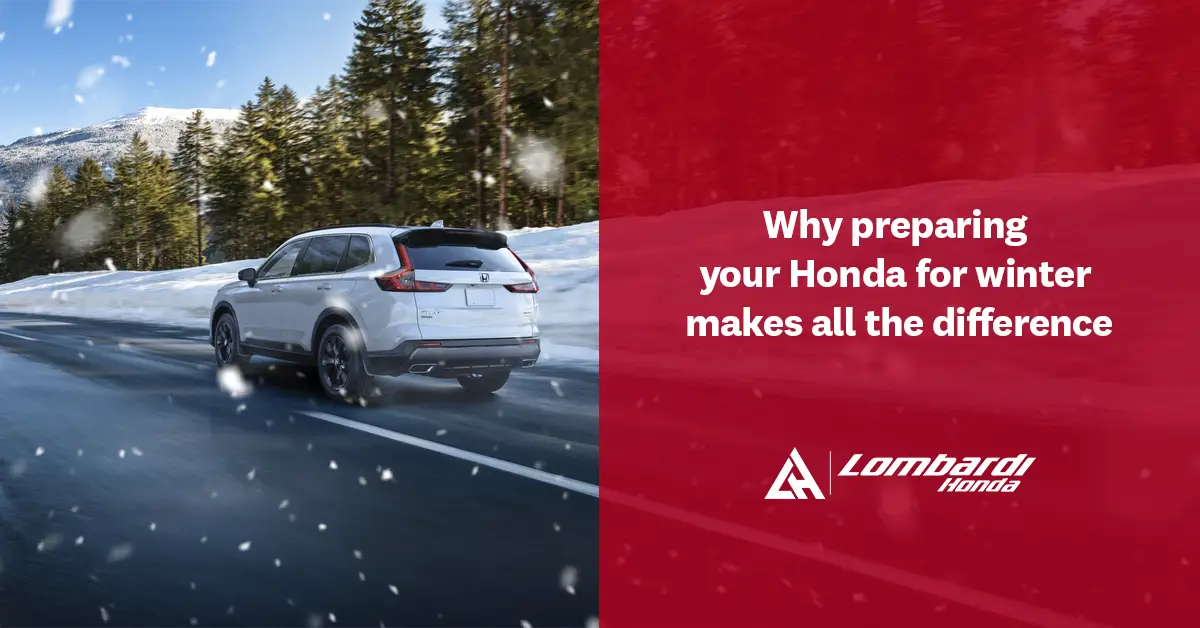It all started one December morning.
Martin, proud owner of a 2023 CR-V, turned the key — silence.
The battery had given up in Montreal’s biting cold.
Since that day, he learned one thing: a well-prepared Honda never lets you down.
Every year, Quebec winters challenge even the most seasoned drivers with snowstorms, icy roads, and wild temperature swings. If you drive a Honda, you already know how reliable your vehicle is — but even the best car needs proper preparation before the deep freeze.
At Lombardi Honda Montreal, our technicians recommend a few simple yet essential checks each fall to help you avoid unpleasant surprises when the first frost hits.
1. Why Winter Preparation Is Essential
Cold weather stresses every component of a vehicle: the battery loses power, fluids thicken, seals freeze, and tires lose traction. According to CAA-Quebec, battery-related breakdowns increase by 30% during cold snaps, and braking distances can double on icy roads if your tires aren’t adapted.
Modern Honda models — whether it’s a Civic, CR-V, or Pilot — rely heavily on electronic systems like Honda Sensing. These systems need clean sensors, proper calibration, and clear visibility to work correctly. That means your defrost fluids, cameras, and sensors must all be in top shape.

2. Tires: Your First Line of Defense
In Quebec, winter tires are mandatory from December 1 to March 15. Beyond the legal requirement, they’re your best protection against slipping and skidding.
For a full comparison between winter, all-season, and all-weather tires, check out our related article:
Winter or All-Season Tires: Which One Should You Choose for Quebec?
Before installing your winter tires, make sure to:
-
Check tread depth (minimum 4.8 mm).
-
Inspect for even wear — poor alignment can reduce traction.
-
Verify tire pressure (it drops roughly 1 psi per °C decrease).
-
Inspect the spare tire and wheel nuts.
Pro tip: Lombardi Honda also offers tire storage services to save space and keep your tires in optimal condition year-round.
3. Essential Mechanical Checks
Battery:
Once your battery is over three years old, it becomes vulnerable to cold. At -18 °C, its capacity can drop by 40%. Our technicians can quickly perform a load test to check its health. Preventive replacement is often cheaper — and far less stressful — than getting stranded roadside. Also, clean off any white corrosion from terminals to maintain conductivity.
Fluids:
-
Engine oil: Use low-viscosity oil (e.g., 0W-20) for easier cold starts.
-
Coolant/antifreeze: Make sure it protects down to -35 °C.
-
Washer fluid: Choose a winter formula rated -40 °C and keep the tank full.
During your winter inspection, Lombardi Honda technicians will also check brakes, belts, and air filters, which can clog faster in cold conditions.
4. Wipers and Visibility
Winter wiper blades feature thicker rubber and enclosed frames to prevent ice buildup. Replace them if they leave streaks or miss spots. Remember: clear vision isn’t just comfort — it’s safety. Honda Sensing relies on the forward camera and sensors to detect obstacles and lane markings accurately.
5. Accessories and Emergency Equipment
Quebec winters are unpredictable. Always keep in your trunk:
-
A telescopic shovel
-
Booster cables
-
A flashlight
-
A blanket
-
Salt or sand
-
A basic emergency kit
Also, rubber winter mats help protect your carpet from salt and slush while making cleanup easier in spring. A remote starter is another smart upgrade — it lets you pre-warm your car while preserving battery life.
6. Tips for Hybrid and AWD Models
If you drive a Honda hybrid, temperature affects the high-voltage battery’s performance. Whenever possible, park indoors, pre-heat before driving, and avoid extremely short trips.
AWD models like the CR-V or Pilot require occasional differential checks and equal tire pressure across all four wheels. And before every drive, make sure your parking sensors, radar, and rear camera are clear of snow or ice.
7. When Should You Book Your Appointment?
Ideally, schedule your winter inspection between mid-October and early November — before the first snow rush. A full inspection at Lombardi Honda Montreal includes:
-
Battery and fluid check
-
Brakes and belts
-
Heating and defrost systems
-
Honda Sensing calibration
-
Tire and suspension inspection
Conclusion
Preparing your Honda for winter is more than just swapping tires — it’s about ensuring safety, comfort, and reliability all season long. With timely maintenance, you’ll enjoy a smooth, stable drive, even on Montreal’s snow-covered streets.
Book your winter inspection today with the Lombardi Honda Montreal service team — and hit the road with total peace of mind.
FAQ – Preparing Your Honda for Winter
When should I prepare my Honda for winter?
Between mid-October and early November, before the first snowfalls. This gives you time to install winter tires, check your fluids, and test your heating system. Service slots fill quickly by mid-November, so book early at Lombardi Honda Montreal.
What are the most important things to check before winter?
Winter tires, battery, wipers, essential fluids (oil, washer, coolant), and heating/defrost systems. Also have your brakes, belts, and Honda Sensing sensors inspected.
Do Honda hybrid models need special winter prep?
Yes. The high-voltage battery is more sensitive to cold. Park indoors when possible, warm up the car before driving, and avoid short trips. Honda service can also run a preventive battery diagnostic.
Can I store my summer tires at Lombardi Honda Montreal?
Absolutely. Lombardi Honda offers secure, climate-controlled tire storage, extending your tires’ lifespan and freeing up space at home.


